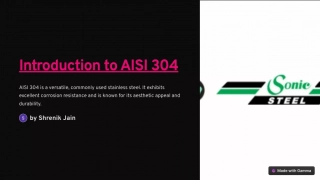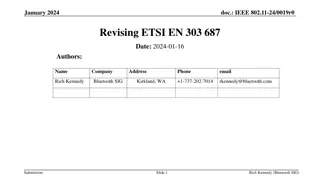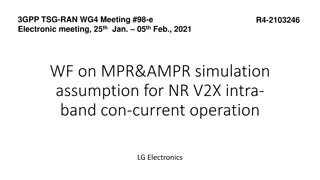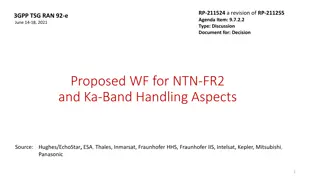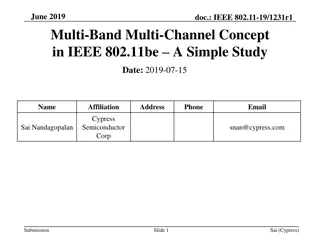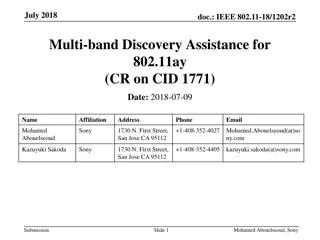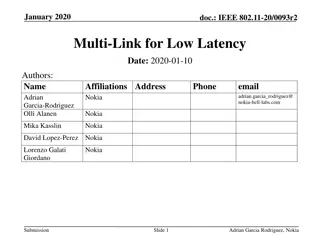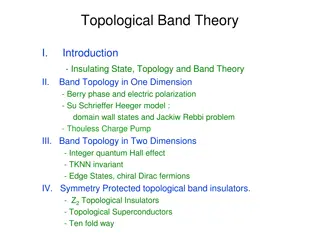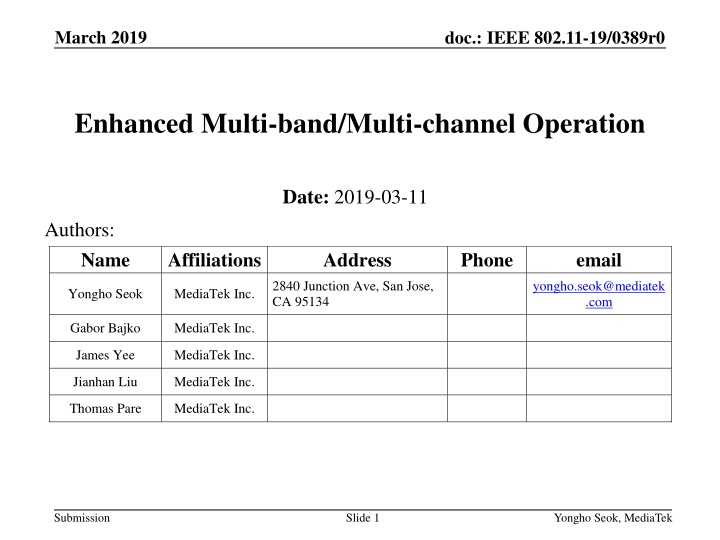
Enhanced Multi-band/Multi-channel Operation in IEEE 802.11-19
Explore the goals and benefits of enhanced multi-band/multi-channel operation in IEEE 802.11-19 for improved throughput, reduced latency, and optimized session switching overhead. This presentation delves into the importance of meeting real-time requirements for various applications like 4k/8k video, virtual reality, gaming, and cloud computing. Learn how leveraging multiple bands and channels simultaneously can enhance per-session performance in wireless communication networks.
Download Presentation

Please find below an Image/Link to download the presentation.
The content on the website is provided AS IS for your information and personal use only. It may not be sold, licensed, or shared on other websites without obtaining consent from the author. If you encounter any issues during the download, it is possible that the publisher has removed the file from their server.
You are allowed to download the files provided on this website for personal or commercial use, subject to the condition that they are used lawfully. All files are the property of their respective owners.
The content on the website is provided AS IS for your information and personal use only. It may not be sold, licensed, or shared on other websites without obtaining consent from the author.
E N D
Presentation Transcript
March 2019 doc.: IEEE 802.11-19/0389r0 Enhanced Multi-band/Multi-channel Operation Date: 2019-03-11 Authors: Name Affiliations Address Phone email 2840 Junction Ave, San Jose, CA 95134 yongho.seok@mediatek .com Yongho Seok MediaTek Inc. Gabor Bajko MediaTek Inc. James Yee MediaTek Inc. Jianhan Liu MediaTek Inc. Thomas Pare MediaTek Inc. Submission Slide 1 Yongho Seok, MediaTek
March 2019 doc.: IEEE 802.11-19/0389r0 EHT Multi-band/Multi-channel Operation As described in the EHT PAR, one of the needs of the EHT program is to provide the high throughput and meet stringent real-time delay requirements of 4k and 8k video, virtual reality or augmented reality, gaming, remote office and cloud computing applications. In order to meet those PAR requirements, in this presentation, we have analyzed how the EHT multi- band/multi-channel operation can increase the per- session throughput and reduce the per-session latency. Submission Slide 2 Yongho Seok, MediaTek
March 2019 doc.: IEEE 802.11-19/0389r0 EHT Multi-band/Multi-channel Operation goals 1) To reduce latency during multi-band and multi- channel operation, it is necessary to reduce the session switching overhead (e.g., switching timeout, frame exchanges). With legacy FST, when switching sessions, the SME of the STA needs to initiate the FST Setup Request and Response frame exchanges as well as the FST Ack Request and Response frame exchanges. Depending on the session switching frequency, the protocol overhead can be quite high. Submission Slide 3 Yongho Seok, MediaTek
March 2019 doc.: IEEE 802.11-19/0389r0 EHT Multi-band/Multi-channel Operation goals 1) To reduce latency during multi-band and multi- channel operation, it is necessary to reduce the session switching overhead (e.g., switching timeout, frame exchanges). Block ACK Data [Seq2, TID1] AP 6GHz Switching procedure should be optimized to reduce the overhead. STA Data [Seq1, TID2] backoff Data [Seq1, TID1] AP 5GHz Block ACK STA Submission Slide 4 Yongho Seok, MediaTek
March 2019 doc.: IEEE 802.11-19/0389r0 EHT Multi-band/Multi-channel Operation goals 2) To improve per-session throughput and per-session latency, MSDUs belonging to single session (e.g., TID) should use multiple bands and/or channels simultaneously. In a legacy multi-band and multi-channel operation (e.g., FST), sessions of an individual STA can be transferred from a channel to another channel, in the same or different frequency bands. But, a MSDUs belonging to single TID can only use single bands and/or channels at any time. There is no per-session throughput improvement. Submission Slide 5 Yongho Seok, MediaTek
March 2019 doc.: IEEE 802.11-19/0389r0 EHT Multi-band/Multi-channel Operation goals 2) To improve per-session throughput and per-session latency, MSDUs belonging to single session (e.g., TID) should use multiple bands and/or channels simultaneously. Data [Seq3, TID1] Data [Seq4, TID1] AP 6GHz STA Block ACK backoff Data [Seq5, TID1] Data [Seq2, TID1] Data [Seq1, TID1] AP 5GHz STA Block ACK Submission Slide 6 Yongho Seok, MediaTek
March 2019 doc.: IEEE 802.11-19/0389r0 EHT Multi-band/Multi-channel Operation goals 3) To reduce overhead, Control information (e.g., Control frames, A-Control information) for a channel can be transmitted in a different channel/band. Allowing out-of-band exchange of Control information can result in more efficient allocation of resources. Submission Slide 7 Yongho Seok, MediaTek
March 2019 doc.: IEEE 802.11-19/0389r0 Conclusion In this contribution we discuss the limitations of legacy multi-band/multi-channel operation and how new multi-band/multi-channel mechanisms can help to meet the EHT PAR requirements. Submission Slide 8 Yongho Seok, MediaTek


